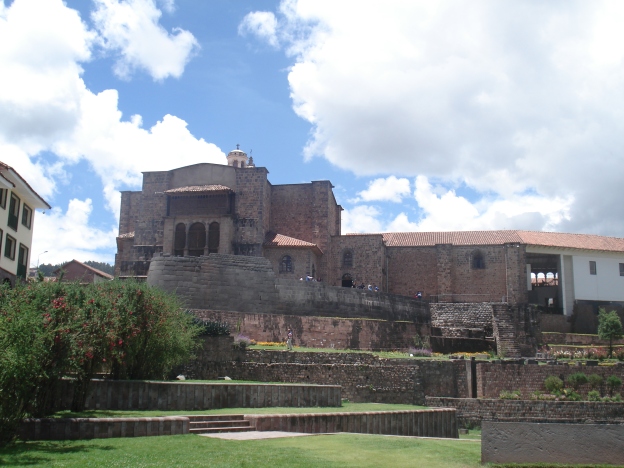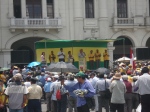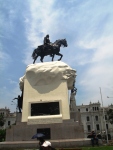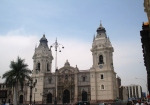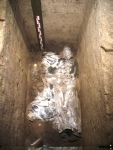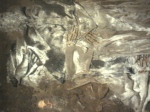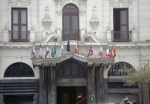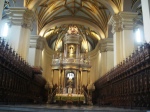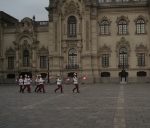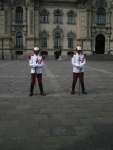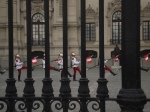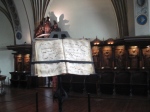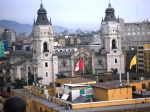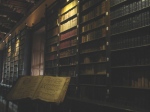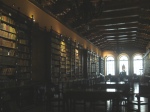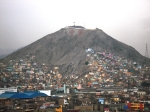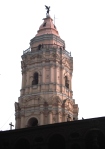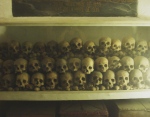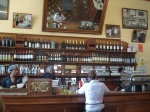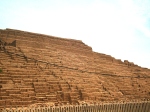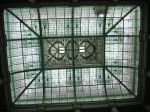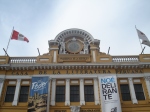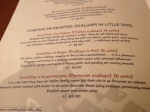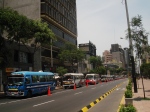
Catedral de Cusco

Cusco at Night

Plaza de las Armas Cusco

cusco plaza las Armas

Hills above Cusco

Mural-Avenida del Sol Cusco

On Avenida del Sol- Mural

on el Dia Internacional de la Mujer

political protest in Cusco

protest march in Cusco

Qoricancha and the Temple of Santo Domingo

Quechua woman with alpaca

San Pedro Market

San Pedro Market, Cusco

San Pedro Market-Juice bar

San Pedro Market- Flours and Grains

When in Cusco, drink Cusqueno beer
Even before the plane started its decent for Cusco, we could see the tops of mountains that appeared to be level with the airplane windows. Everyone talks about how high it is in Cusco—but until you’re there, it’s just talk. At 3,399 meters (11,152 feet), it’s about as high as we’ve ever been without ascending a mountain by trail or chairlift. So many warned us about altitude sickness, but we both had barely any problem, aside from a little shortness of breath the first day and a mild headache. I had a prescription for Diamox, but decided not to take it after I read the contraindications. We followed the popular advice for altitude sickness:
1 – drink plenty of water – check!
2–get enough rest and take naps – check!
3—drink lots of coca tea – check!
4—move a little slower – check!
5 – don’t drink alcohol…er…four out of five ain’t bad, right?
Our time in Cusco was brief but eventful. We visited the Cathedral, and really enjoyed the leadership of Mario, a very knowledgeable local guide. Wandering the town of Cusco itself was fun, in spite of having to thread through a gauntlet of locals hawking everything from tours to shoe shines, massages to banquets…tourism is big business in Cusco.
Speaking of business, I have to mention the Hotel Casablanca. It is a very inexpensive budget hotel in a central locaction in the village of Cusco. The rooms are clean and perfectly nice, with private baths, hot water, cable TV. There was even a high-speed internet connection, something I never expected in a town where so many of the local people still dress in traditional costumes and carry heavy loads up and down the mountains on their backs. At times it looks like it could be 500 years ago—and then somebody pulls out their iphone, and the illusion is broken. The owner of the hotel, Juan, is in his 70’s and moves and speaks very slowly…but he is the most helpful person we’ve ever encountered in our travels. Not only did he pick us up at the airport, he drove us around a bit first so that we’d have the lay of the land. In addition to the usual advice about altitude, he had the staff carry our bags upstairs, even our day packs, lest we suffer from altitude sickness, and they immediately served us coca tea in our room.
On the day we traveled to Machu Picchu from Cusco, Juan checked our tickets to be sure we knew the how’s and where’s of getting there—Peru rail, combination train and bus. Since there is more than one station in Cusco, and the arrangements can be complicated, he not only had a taxi waiting to take us to the station at 5:30 a.m, he was up waiting for us in the lobby, and accompanied us in the taxi to be sure we got off without any problems. Really sweet! When it was time to leave Cusco, his daughter, Rocio, checked on our flights and printed our boarding passes without our asking. The staff brought us tea, water, and served a breakfast of our choosing each morning. We really thought we felt like part of the family–this was a budget hotel with 5-star service. http://www.booking.com/hotel/pe/casablanca.en-gb.html?aid=311984
We enjoyed lots of things about Cusco. Not least was a fabulous dinner at Cicciolina, near the Cathedral. Great service and outstanding cuisine at a fair price.
On the main avenue, Avenida del Sol, the stonework of Qorinkancha, an ancient Inca temple once completely covered in gold, stands as the foundation of the church of Santo Domingo, built on the spot–after removing the gold, of course
We also love to visit markets, and the market of San Pedro is fascinating for the produce, meats, breads, cheeses, and for the native Andean people who bring their goods to sell there. Watermelon is in season, and we saw people munching on big hunks of melon nearly everywhere we went.
Just strolling through the village was a lovely experience, with extraordinary views of the sky and mountains at every turn. On our last day, we stopped for coffee at the Plaza de Armas, the main square where the Cathedral stands. While we were sitting and sipping, there were two groups celebrating The International Day of the Woman. One group gave out purple ribbons, carried purple balloons, and insisted in giving out “abrazos – gratis” (free hugs) to every woman they saw. A little weird if you’re not accustomed to embracing strangers on the street. The second group was a bit older on average, with about a 50/50 mix of modern and traditional native attire worn by the participants. They played drums and carried signs protesting poor treatment of women and workers, as well as lies and corruption of government and politicians. I think they might be called “Occupy the Andes.” It made for a colorful morning.
Of course, Cusco is the starting point for most people going to Machu Picchu, either by hiking trails, or by rails or roads. That experience, and the corresponding photos, will have to wait for another post. Enjoy the pics—click on one and toggle through using the arrows to see the slide show.











































